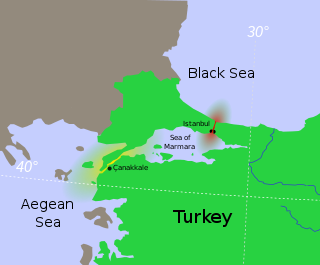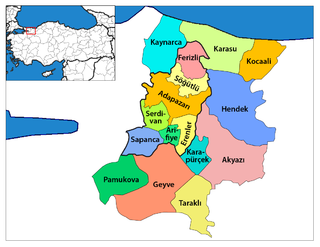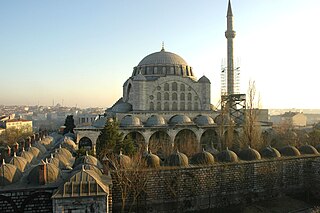
The Sea of Marmara, also known as the Sea of Marmora or the Marmara Sea, is a small inland sea located entirely within the borders of Turkey. It connects the Black Sea to the Aegean Sea via the Bosporus and Dardanelles straits, separating Turkey’s European and Asian sides. It has an area of 11,350 km2 (4,380 sq mi), and its dimensions are 280 km × 80 km. Its greatest depth is 1,370 m (4,490 ft).

Edirne, historically known as Adrianople, is a city in Turkey, in the northwestern part of the province of Edirne in Eastern Thrace. Situated 7 km (4.3 mi) from the Greek and 20 km (12 mi) from the Bulgarian borders, Edirne was the second capital city of the Ottoman Empire from 1369 to 1453, before Constantinople became its capital.

Rumelihisarı or Boğazkesen Fortress is a medieval Ottoman fortress located in Istanbul, Turkey, on a series of hills on the European banks of the Bosphorus. The fortress also lends its name to the immediate neighborhood around it in the city's Sarıyer district.

The North Anatolian Fault (NAF) is an active right-lateral strike-slip fault in northern Anatolia, and is the transform boundary between the Eurasian Plate and the Anatolian Plate. The fault extends westward from a junction with the East Anatolian Fault at the Karliova Triple Junction in eastern Turkey, across northern Turkey and into the Aegean Sea for a length of 1200−1500 kilometers. It runs about 20 km south of Istanbul. The North Anatolian Fault is similar in many ways to the San Andreas Fault in California. Both are continental transforms with similar lengths and slip rates. The Sea of Marmara near Istanbul is an extensional basin similar to the Salton Trough in California, where a releasing bend in the strike slip system creates a pull-apart basin.

Avcılar is a municipality and district of Istanbul Province, Turkey. Its area is 50 km2, and its population is 452,132 (2022). It is on the European side of the city, just to the west of the Küçükçekmece inlet of the Sea of Marmara.

The Bayezid II Mosque is an early 16th-century Ottoman imperial mosque located in Beyazıt Square in Istanbul, Turkey, near the ruins of the Forum of Theodosius of ancient Constantinople.

Geyve is a municipality and district of Sakarya Province, Turkey. Its area is 662 km2, and its population is 50,799 (2022). The closest international airport is Istanbul Sabiha Gökçen International Airport, 139 km (86 mi) from Geyve. It is the largest district of Sakarya Province in terms of area. Geyve is located at the foot of Geyve Gorge, which is set between two mountain ranges and lies along the Sakarya River. Geyve region has an impressive green landscape and productive nature. Geyve is relatively close to many important cities in Turkey; 179 km (111 mi) to Istanbul, 30 km to Adapazarı, 75 km (47 mi) to Izmit, 139 km to Bursa, 156 km (97 mi) to Eskişehir, 167 km (104 mi) to Bolu by road.

The 1999 İzmit earthquake had a moment magnitude of 7.6 and struck Kocaeli Province, Turkey on 17 August. Between 17,127 and 18,373 people died as a result, and the damage was estimated at US $6.5 billion. It was named for the epicenter's proximity to the northwestern city of İzmit. The earthquake occurred at 03:01 local time at a shallow depth of 15 km (9.3 mi). A maximum Mercalli intensity of X (Extreme) was observed. The earthquake lasted for 37 seconds, causing seismic damage, and is widely remembered as one of the deadliest natural disasters in modern Turkish history.

The Mihrimah Sultan Mosque is a 16th-century Ottoman mosque located near the Byzantine land walls in the Edirnekapı neighborhood of Istanbul, Turkey. It was commissioned by Mihrimah Sultan, the daughter of Suleiman the Magnificent, and designed by the chief imperial architect Mimar Sinan. Sited on the summit of the Sixth Hill near the highest point of the city, the mosque is a prominent city landmark.

The Grand Mosque of Bursa is a historic mosque in Bursa, Turkey. It was commissioned by the Ottoman Sultan Bayezid I to commemorate his great victory at the Battle of Nicopolis and built between 1396 and 1399. The mosque is a major monument of early Ottoman architecture and one of the most important mosques in the city, located in the heart of the old city alongside its historic markets.
The 1943 Tosya–Ladik earthquake occurred at 01:20 local time on 27 November, near Tosya, Kastamonu Province, in northern Turkey. The earthquake had an estimated moment magnitude of 7.5–7.7 and a maximum felt intensity of XI (Catastrophic) on the MSK-64 scale. Its effects were observed for over 45,000 km2. The earthquake was felt in Trabzon, Isparta, Elazığ, Zonguldak and Yozgat. Damage was seen in Kastamonu, Çankırı, Çorum, Amasya, Samsun, Tokat, Sinop and Ordu. As a result of the earthquake, more than 2,500 were killed and 5,000 were injured.
The 557 Constantinople earthquake took place on the night of December 14. This earthquake, described in the works of Agathias, John Malalas, and Theophanes the Confessor, caused great damage to Constantinople, then capital of the Byzantine Empire in a region frequently afflicted with earthquakes. More minor quakes had preceded the large event, including two in April and October respectively. The main quake in December was of unparalleled ferocity, and "almost completely razed" the city. It caused damage to the Hagia Sophia which contributed to the collapse of its dome the next year, as well as damaging the walls of Constantinople to the extent that Hun invaders were able to penetrate it with ease the following season.

The Armutlu Peninsula is a peninsula extending westward into Marmara Sea in the Anatolian section of Turkey. In addition to Yalova Province, parts of Kocaeli Province and Bursa Province are on the peninsula.
The 1894 Istanbul earthquake occurred in the Çınarcık Basin or Gulf of Izmit in the Sea of Marmara on 10 July at 12:24pm. The earthquake had an estimated magnitude of 7.0. At least an estimated 1,349 people were killed in towns around the Gulf of Izmit such as Yalova, Sapanca and Adapazarı, and in Ottoman Constantinople. The main shock caused a tsunami 1.5 metres (4.9 ft) high.
An earthquake occurred in the northern Aegean Sea between Greece and Turkey on May 24, 2014. It had a moment magnitude of 6.9 and a maximum Mercalli intensity of VIII (Severe). Serious damage was reported on the Turkish island of Imbros and the cities of Edirne and Çanakkale, as well as on the Greek island of Lemnos. The earthquake was felt in Bulgaria and southern Romania. Several aftershocks followed the main shock, the strongest measuring 5.3 ML. This aftershock struck the Gulf of Saros at 12:31 local time.

2019 Istanbul earthquake was a 5.8 magnitude earthquake that rocked the south-west of Istanbul on 26 September 2019 at 13:59 local time.

The 1766 Istanbul earthquake was a strong earthquake with epicenter in the eastern part of the Sea of Marmara, in the Çınarcık Basin which occurred in the early hours of Thursday morning, 22 May 1766. The earthquake had an estimated magnitude of 7.1 on the surface-wave magnitude scale, and caused effects in a vast area extending from Izmit to Rodosto. In this area, the earthquake was followed by a tsunami which caused significant damage. The earthquake of 1766 was the last major earthquake to rock Constantinople because of a rupture of the North Anatolian Fault in the Marmara region.
The Çınarcık Basin is a submarine tectonic basin located in the Sea of Marmara, in Turkey.
The 1899 Aydın–Denizli earthquake which struck present-day Turkey on September 20 resulted in between 1,117 and 1,470 fatalities. Heavy damage was reported in the provinces of Aydın and Denizli. The shallow normal-faulting earthquake had a maximum Modified Mercalli intensity of IX (Violent). Estimates of the seismic magnitude range from 6.5 to 7.1 .
The 1766 Marmara earthquake occurred on 5 August; the second major earthquake to strike the Sea of Marmara region of present-day Turkey that same year. Estimates of the earthquake's moment magnitude (Mw ) range between 7.4 and 7.6. The earthquake was caused by strike-slip movement along a segment of the North Anatolian Fault. There was further damage and casualties in the Sea of Marmara area which had been affected by another major earthquake in May 1766. The worst affected areas were Tekirdağ and Gelibolu.
















